Media Monitoring: Definition, Benefits & Strategy for 2026
Table of contents
People talk about brands and products online. In September 2025, iPhone 17 gained over 195k mentions. The main sources of reach were Instagram, news, and YouTube. 83% of those mentions are positive. People mostly complain about problems with the WiFi connection. How do I know that? Simple. I checked my media monitoring project.
When people mention your brand on social media, you get notifications.
But what about untagged media mentions?
And those posted on blogs, news sites, podcasts, newsletters, or forums?
They bring you non-social reach. You should track them as well.
That’s where monitoring comes in handy. Because it tracks multiple media channels.
Market forecast predictions:
- The media monitoring tools market is expected to reach about $6.3 billion by 2025 and grow to $30 billion by 2035.
- The social media listening market is projected to reach $9.62 billion by 2025 and around $118.43 billion by 2030.
What is media monitoring? Definition
Media monitoring is the process of tracking, collecting, and analyzing mentions of a brand, person, organization, or topic across various media channels.
In simple words: Media monitoring means watching what people say about you or your brand online and in the news.
It helps you:
- See who is talking about you
- Know if people are saying good or bad things
- Find out where they are talking — like on social media channels, blogs, or news websites
- Understand what people think about your company, product, or campaign
Key elements of comprehensive media monitoring in 2026:
- Data collection: Real-time gathering of mentions from traditional and digital media sources
- Sentiment analysis: Evaluating whether mentions are positive, negative, or neutral
- Advanced filtering: Sorting mentions by importance, sentiment, reach, source, intent, language, geolocation, and influencer score
- Analysis & insights: Turning raw data into actionable insights
- Reporting: Generate advanced reports to share with your team or clients
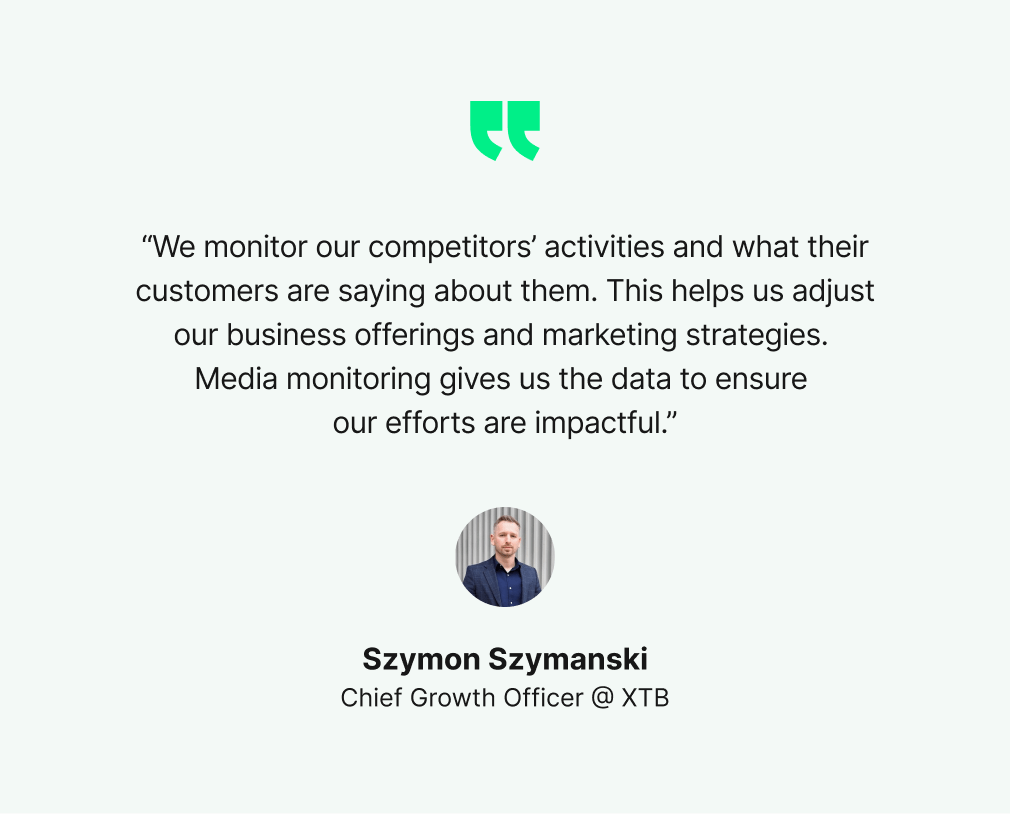
What is AI media monitoring?
AI media monitoring helps you track what people say about your brand faster, smarter, and with deeper insights.
In simple words: Instead of just collecting mentions, the AI-powered system also understands, analyzes, and summarizes them for you automatically.

Why is it important in 2026?
AI media monitoring transforms raw media mentions into actionable, intelligent insights faster and more accurately.
You’ll save massive amounts of time compared to manual monitoring. That’s the point.
Here’s a list of AI-powered features that each media monitoring software should offer in 2026:
- Better sentiment analysis: Going beyond positive/negative/neutral to detect emotions like admiration, anger, disgust, fear, joy, and sadness
- Built-in AI chat (just like ChatGPT): Top tools provide a chat based on your monitoring projects, so you don’t have to analyze data manually, and it delivers precise answers
- Topic clustering and analysis: AI can group mentions into trending topics or conversation clusters automatically
- Real-time anomaly spotting: AI automatically spots unusual or unexpected changes in media data and explains what happened
- Smart insights: Automatically generated summaries, trends, and recommendations created by Artificial Intelligence based on your media data
In 2026, media mentions became more important than ever for SEO and GEO. They strongly impact the frequency of brand appearance in AI Overviews, ChatGPT, Perplexity, and other LLMs. The more mentions, the stronger the expositions.
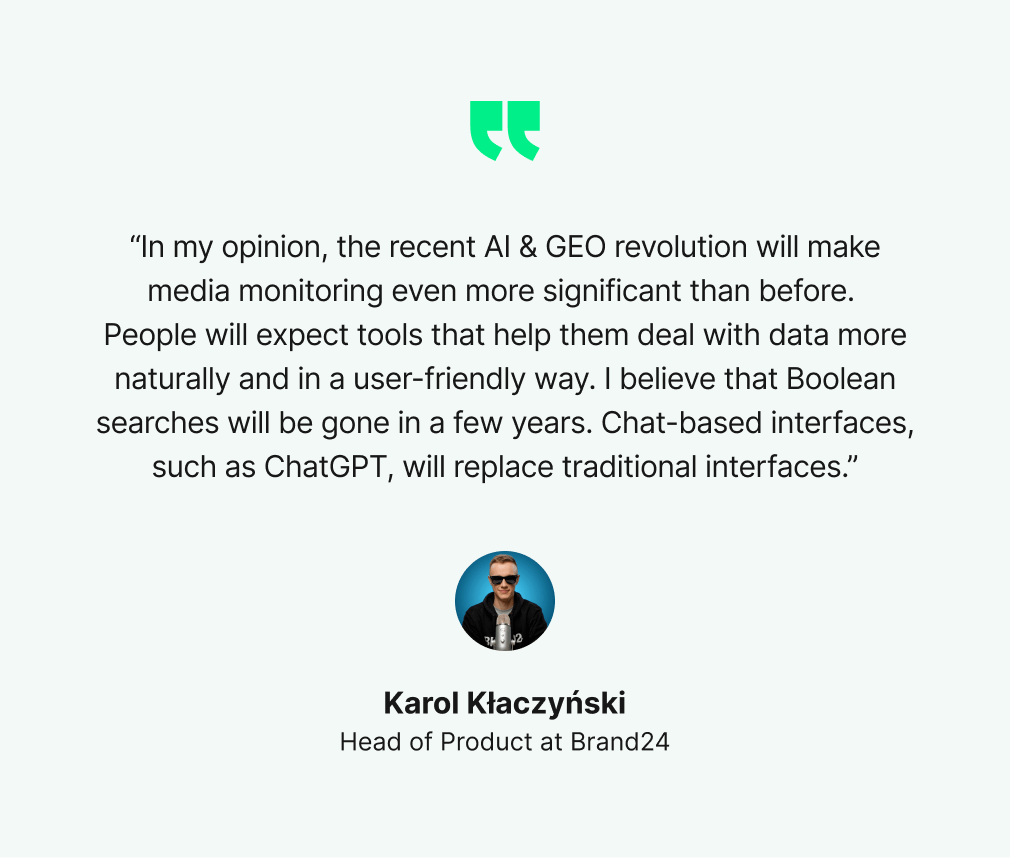
Media monitoring and analysis
Those two approaches go hand in hand. They work as connected steps in one powerful process.
In a nutshell: Media monitoring answers the question: “What is being said and where?” Media analysis answers: “What does this data mean for us?”
| Media monitoring | Media analysis |
| Collect and track mentions of your brand, product, or topic | Understand the meaning behind the mentions |
| Focus on what is being said and where | Focus on why it’s being said and what to do about it |
| Gathers data from various media channels (social, news, blogs, reviews, podcasts, etc.) | Interprets the data to find trends, sentiment, impact, and opportunities |
| Act as the first step – real-time or ongoing tracking | Act as a second step – deeper analysis after collecting enough data |
How do they work together?
Media monitoring is about collecting information, such as “Your brand was mentioned 1,200 times on X and Reddit today,” while media analysis is about making sense of that information, such as “80% of mentions are positive, mostly about your new campaign.”
How to implement media monitoring?
Okay, you know what media monitoring is; now it’s time to learn how it works.
As our clients say, success depends on setting up your project correctly and knowing how to effectively respond to the insights you collect.
Let’s dive in!
Step 1: Choose your goal
Media monitoring can serve many purposes depending on your role, industry, and business strategy priorities.
Here are some of the most common goals:
- Reputation management: protect brand image, detect crises early, track sentiment
- PR and communications: measure campaign impact and reach, track media coverage, benchmark share of voice, monitor press releases
- Competitive and market intelligence: monitor competitors, spot industry trends, identify consumer needs
- Customer and community: gather feedback, respond to questions and complaints, understand opinions, find advocates/critics
- Business impact: prove ROI, tie media exposure to sales, provide reports for decision-making
Of course, those goals might (or even should) evolve in the future.
At the beginning, the most important thing is to have a starting point.
So, what do you want to monitor? Open your notebook and list the key aims right now 😉
Step 2: Pick a monitoring tool
When selecting a monitoring tool, I recommend paying attention to 3 key aspects: the number of monitored sources, features, and cost-effectiveness.
Let’s take a closer look at them.
1. Monitoring sources
The number of monitoring sources matters. The more the better news coverage. Here’s what you can track:
- Traditional media: newspapers, TV, radio (sometimes via third-party providers)
- Online media: news websites, blogs, forums, Reddit, Quora, Medium
- Social media: Facebook, X (Twitter), LinkedIn, Instagram, TikTok, Telegram, Bluesky, etc
- Review sites: TripAdvisor, Booking, Yelp, App Store, Google Play, Trustpilot, app stores
- Podcasts and video platforms: YouTube, Twitch, Spotify, Soundcloud
- Internal sources: customer support tickets, community groups
- Newsletters
- Multilingual and regional sources
2. Features
Features are the crème de la crème of software.
A solid tool should continually improve the quality of monitoring and sentiment analysis, raise the number of monitoring sources, and incorporate AI features.
Here’s a list of features you can find in media monitoring solutions in 2026:
- Wide coverage: News, social, blogs, forums, podcasts, TV, radio, video, and even images.
- Real-time alerts and reports: Instant notifications on spikes, crises, or sentiment changes.
- AI features: Sentiment/emotion analysis, automatic summaries, topic clustering, trend & intent detection.
- Advanced search & filtering: Boolean queries, language/region filters, noise reduction.
- Analytics: Reach & engagement metrics, geo & demographic insights, influencer finding.
- Competitive intelligence: Share of voice, benchmarking vs. rivals.
- Integrations: APIs, CRM, Slack/Teams, PR tools.
Most of the tools monitor only online sources. So if you care about broadcast media, consider checking Meltwater or Cision.
3. Cost-effectiveness
Currently, you can find tools on the market ranging in price from $99 to several thousand dollars per month.
What is the reason for this?
- The price depends on the number of keywords you want to monitor and the features you want to use.
- Some all-in-one social media management tools offer monitoring as an add-on for which you have to pay extra.
- To calculate the total cost, you need to sum the subscription fee (monthly/annual) + add-ons (extra mentions, extra users, advanced AI features, or historical data).
Many providers are flexible, allowing you to negotiate the final cost and adjust the subscription plan to your actual needs.
So do not hesitate to contact the sales team. They don’t bite 😉
Step 3: Select the keywords to monitor
Alright, now it’s time to select monitoring keywords that match your needs.
Those could be:
- Brand & products:
- company names, e.g., Apple, Apple Inc, Apple Corporation,
- product names, e.g., iPhone 16, iPad Pro, MacBook Air M2,
- slogans, e.g., Think Different,
- misspellings, e.g., Aple, i-phone, mac book,
- executives and founders, e.g., Tim Cook, Jeff Williams,
- Competitors:
- rival brands, e.g., Samsung, Huawei, Xiaomi,
- products, e.g., Galaxy S24, Watch 6 Classic, MateBook X,
- hashtags, e.g., #TeamGalaxy, #AndroidVsApple,
- Industry terms:
- sector buzzwords and trends, e.g., generative AI, green tech, smart home,
- problems, e.g., battery drain, Face ID not working,
- Campaigns and events:
- campaign names, e.g., Shot on iPhone,
- hashtags, e.g., #AppleEvent, #iPhone16,
- conferences, e.g., Apple September Event, Scary Fast,
- Issues and risks:
- crisis terms and complaints, e.g., iPhone overheating, App Store monopoly,
- negative phrases, e.g., Apple sucks, hate my iPhone, never buying Apple.
Important: Most of the media monitoring tools base their pricing on the number of monitored keywords. That means the more keywords you want to track, the more you need to pay. So choose wisely!
Step 4: Gather and analyze results
Media monitoring tools look up and analyze publicly available online content from websites and social media platforms based on the API of these platforms.
The analysis part is one of the most valuable parts of media tracking projects. Tools analyze gathered data and present them in an actionable way.
What pieces of information will the media monitoring service give you?
- The volume of mentions: That’s a basic media monitoring metric. It will tell you how popular your keyword is and on which platforms.
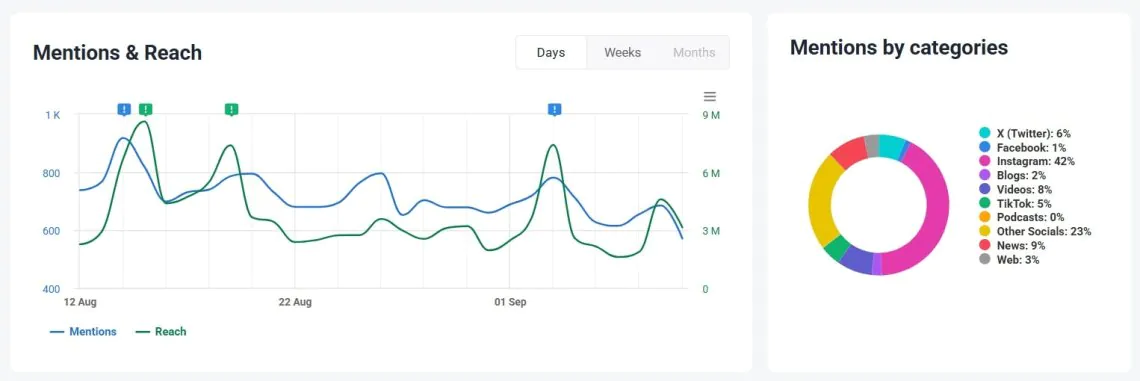
- Sentiment analysis: Analyzing the media mentions by sentiment will tell you how your audience feels about your brand, product, or service.
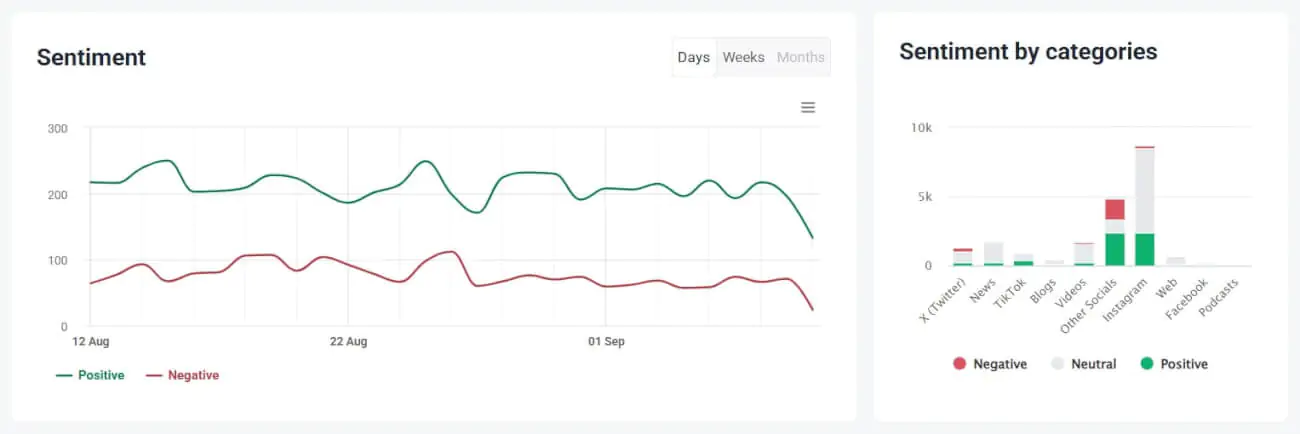
- Estimated reach: To know how many people could have seen your posts. This metric will help you measure the results of marketing or brand awareness campaigns. For example, Brand24 will calculate both non-social and social media reach.
- The share of voice: The share of voice will indicate what part of the market your brand owns compared to your competitors.
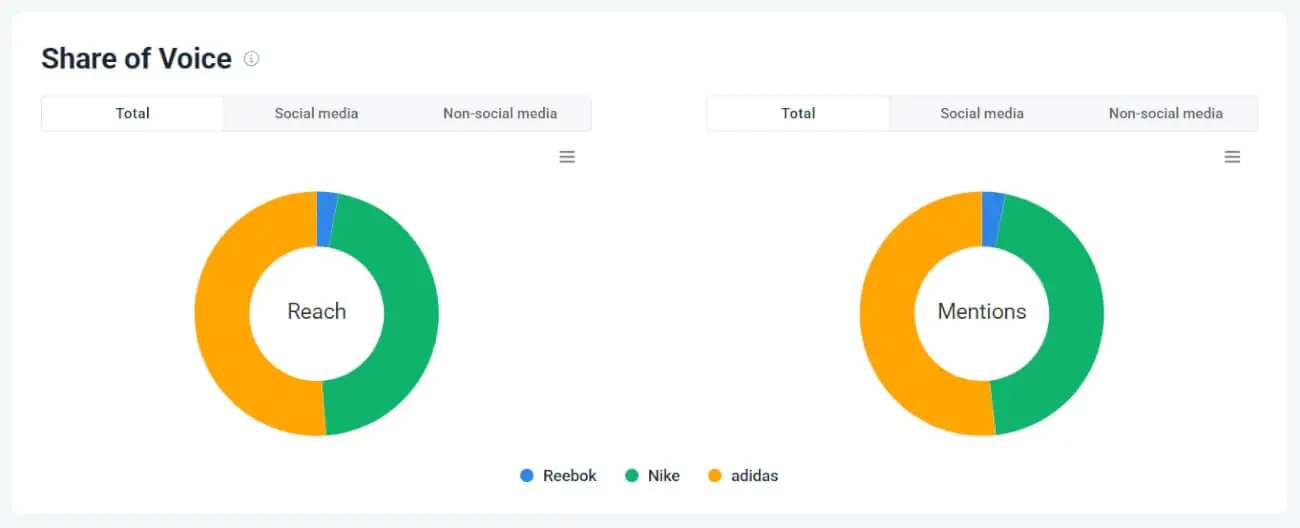
- Top public profiles: Media monitoring platforms will identify social media accounts talking about your product. This metric can help you run an influencer marketing campaign.
- Trending hashtags: A carefully generated list of trending hashtags that will help you boost your brand visibility and reach new audiences.
- Emotion analysts: Companies can gauge how the public feels about their brand, products, or services by understanding the emotional tone of media coverage and social discussions.
- Geo analysis: Different regions can have vastly different perceptions and reactions to the same brand, product, or event. Geo analysis helps in understanding these regional differences.
- Presence score: The presence score indicates how visible and prominent a brand or topic is in the media landscape.
- Reputation score: The reputation score provides a tangible metric to understand how a brand is perceived. A sudden drop in the reputation score can signal a potential crisis or negative sentiment shift.
- Context of a discussion: Understanding the context helps accurately gauge the sentiment and importance of a mention. Also, context helps distinguish discussions that are truly relevant to your brand or topic.
What’s great is that some AI-powered tools present a clear insights summary, so you don’t have to waste your time on mentions analysis.
Here, you can see the summary of my Reebok project:
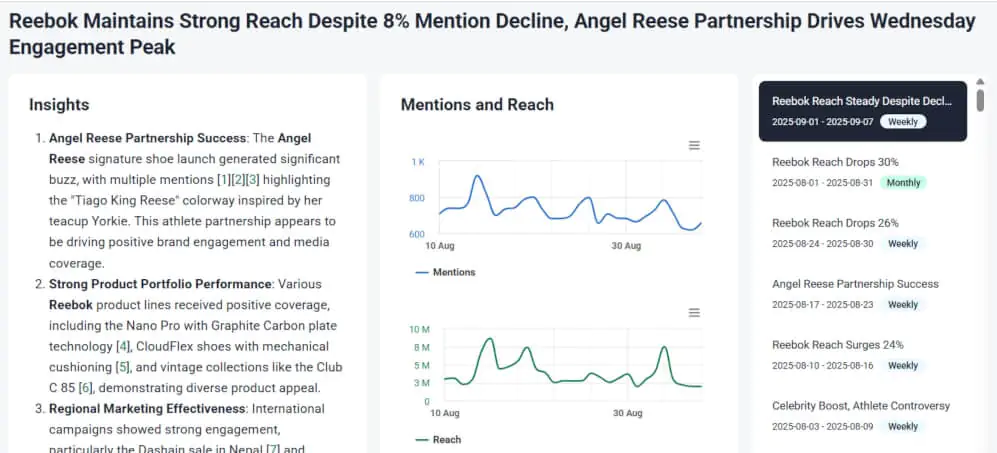
Importance of media monitoring in 2026
In 2026, media tracking is more critical than ever because online conversations move faster than ever before, and the media environment has become more complex and AI-driven.
Conversations about brands can spread globally in minutes across TikTok, X (Twitter), Reddit, blogs, podcasts, and news.
Having this in mind, it’s good to know what’s being said about your business online: by your happy and unhappy customers, by industry media, or by competitors.
So, why is media monitoring important?
1. Massive volume of information
In 2026, the internet is more saturated than ever. From social media to podcasts, news sites, forums, and TikTok, brands are mentioned everywhere, but not all mentions matter.
AI-powered tools can filter the noise, allowing brands to focus only on relevant, high-impact conversations.
How can you take advantage:
- Detect relevant mentions across social media posts, news, blogs, podcasts, and forums
- Avoid missing meaningful conversations about your brand or competitors
- Get real-time alerts that something important is going on
2. Brand reputation management
Consumers in 2026 buy from brands they trust. Studies show that companies with a strong, positive reputation see higher customer retention, easier hiring, and stronger stock performance.
Furthermore, analyzing customer sentiment helps businesses adjust their marketing strategies effectively.
How can you take advantage:
- Respond timely to any negative review that could damage your brand’s reputation
- Improve products and services based on public feedback from the target audience
- Prepare for crises by understanding public perceptions and industry trends before situations escalate
3. Real-time crisis management
Crises don’t wait for business hours. Monitoring tools act as your early warning system, giving PR teams time to react before the damage is done.
Monitoring customer feedback and complaints on social media channels and review sites helps PR professionals address issues quickly and improve customer service.
How can you take advantage:
- Quickly detect the spike in negative mentions and find the cause of the problem
- Listen to consumer complaints during a crisis to plan effective communication and conflict resolution
- Monitor the sentiment trends to judge whether the addressed resolution works
4. Competitor monitoring & analysis
In 2026, using a media monitoring solution for competitor analysis is one of the smartest ways to stay ahead of the curve.
Understanding competitors’ strengths through media mentions can inform your product development or marketing strategies.
How can you take advantage:
- Monitor competitors’ media coverage, share of voice, hashtags, products, campaigns, and audience sentiment
- Study their successes and failures to avoid their PR or product mistakes, and adopt tactics from high-performing campaigns
- Fill the gaps by monitoring what their audience is asking for but not getting
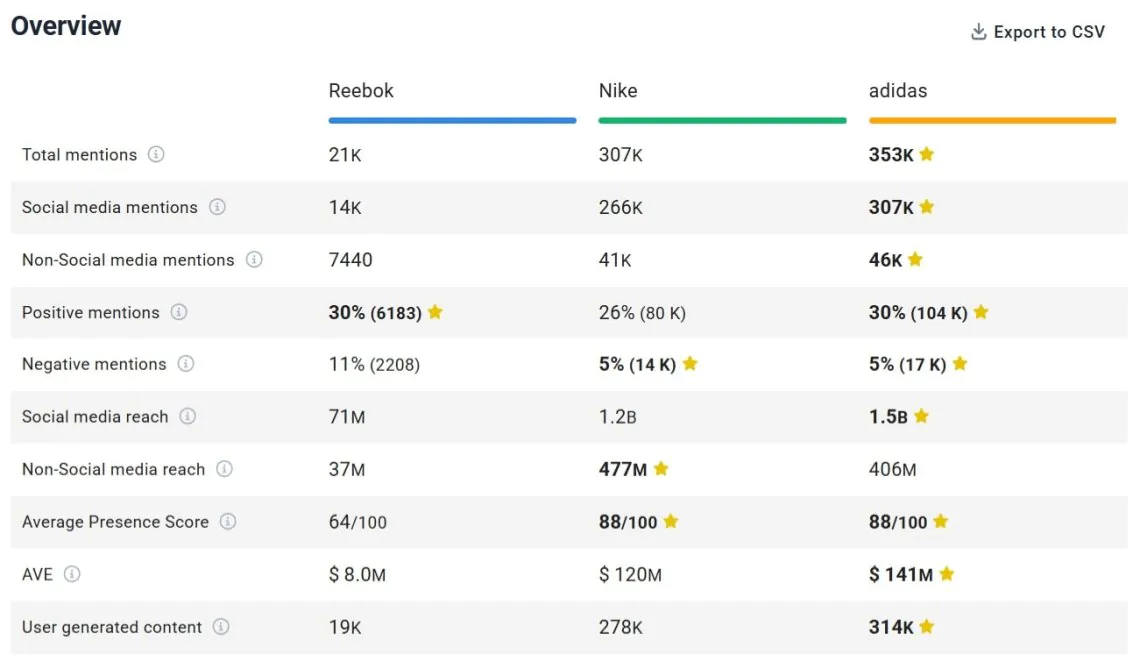
5. Industry trend identification
Trend identification and analysis in 2026 is a game-changing strategy. It empowers you to spot what’s gaining traction before your competitors do.
Media monitoring lets you identify new keywords, hashtags, or conversation themes before they go mainstream.
How can you take advantage:
- Get early alerts on trending hashtags, keywords, or topics
- Identify new consumer interests and behaviors
- Launch timely content or products that ride the trend
Listen, learn, act
To sum up, media monitoring can be a beneficial tool if we use it properly and understand how it works.
Key takeaways:
- To effectively leverage media monitoring, you need to set clear goals and select relevant keywords to track.
- Not every tool monitors traditional and print media such as TV, radio, newspapers, and outdoor.
- Some social media tools offer monitoring as an extra paid add-on.
- Look for solutions that offer advanced AI features that will do the job for you.
- Mentions monitoring is just the first step. The most important thing is to find valuable insights from data and take action.
I hope that now you know more about what media monitoring and analysis are and why it is worth your attention.




